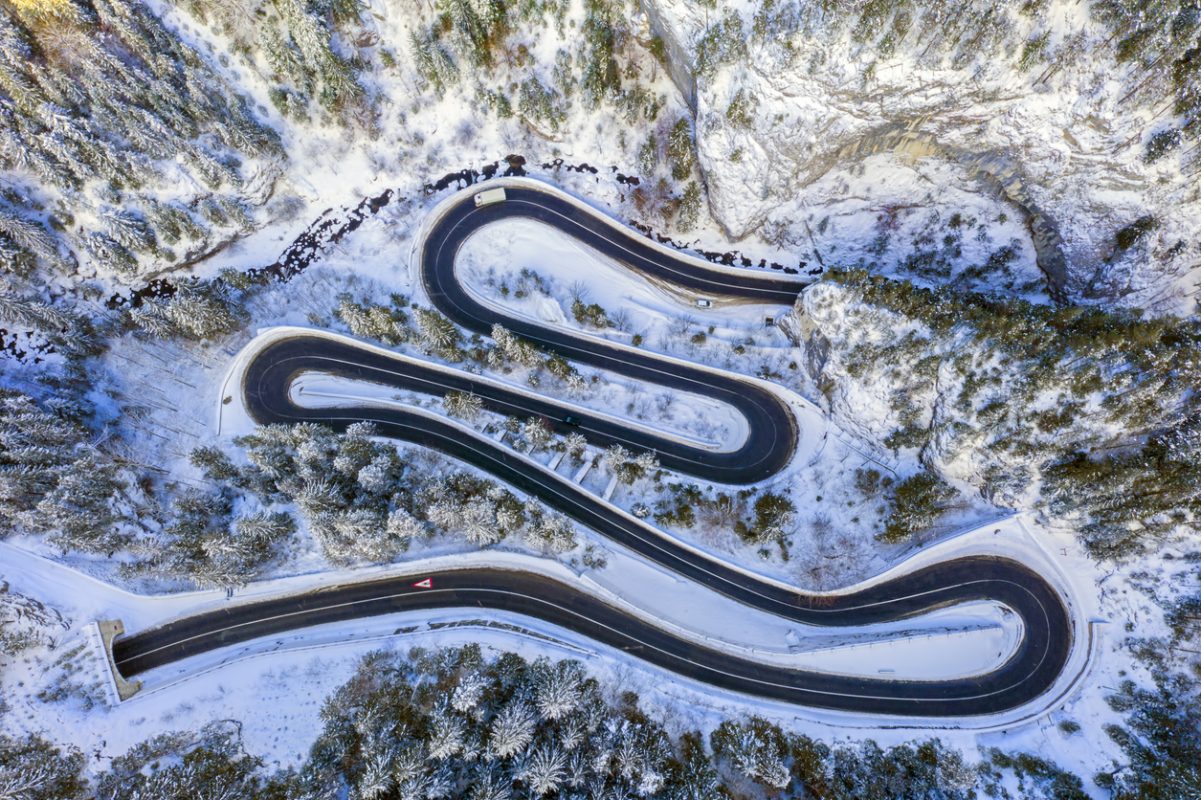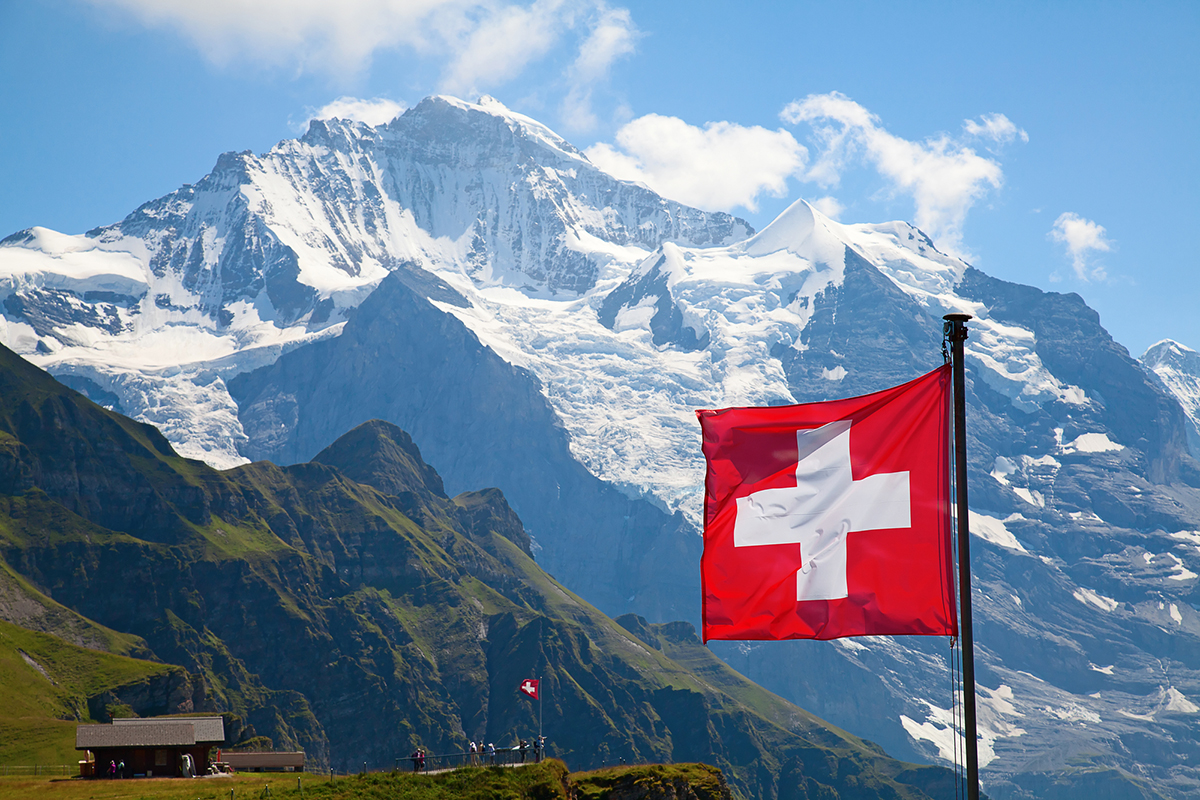One of Europe’s most beautiful countries, Switzerland is an idyllic destination to travel to. However, while road-tripping is dreamy, if you’re driving in Switzerland in winter, there’s quite a lot to consider!
In this article, we chat all about winter driving in Switzerland, whether you should opt for road-tripping at this time of year, and how to stay safe on the roads.
What’s driving in Switzerland in winter like?
Switzerland in winter: it’s a spectacle, but there’s a lot to consider!
It snows a lot in Switzerland in winter in much of the country (although not all). Pair that with icy roads winding around the Alps and particular traffic regulations, and driving in Switzerland in winter definitely has its challenges!
Here are some of the main hazards to be aware of when driving in Switzerland in winter:
- low temperatures in Alpine regions causing icy and snowy roads
- winding roads around the mountains
- tourists who aren’t used to the road conditions
However, all that said, the roads in Switzerland are typically excellent. They’re well-gritted and cleared, and most Swiss locals are well-versed in the rules of the road.
Is driving in Switzerland in winter safe?

If you aren’t accustomed to driving in snowy conditions, I wouldn’t recommend driving around the Swiss Alps in winter.
Cities like Basel usually have milder, less extreme weather, so you probably need less snow experience if you’re driving in these areas.
However, it can snow anywhere in the country throughout the winter season, so if you’re planning on driving in Switzerland in freezing conditions, be prepared!
Alternatives to driving in Switzerland in winter
Switzerland has an excellent rail network, with connections to most major cities and lots of towns. The trains are typically reliable, modern and clean; if your destinations are connected by rail, I’d definitely recommend using this mode of transport instead of driving!
Bus services, such as FlixBus, also connect other destinations. These can be a great alternative if you don’t want to drive in winter weather.
How to prepare your vehicle for Swiss winter weather

If you’re driving your own vehicle in Switzerland in winter, there are a few things to consider!
Here’s a to-do list to consider before heading out:
- Winter Maintenance Checks: Before driving in Switzerland, inspect your vehicle – check brake functionality and ensure lights are fully operational.
- Winter Tyres and Snow Chains: Winter tyres are very important traction on the ice – in fact, tyres in Switzerland must be suitable for icy and snowy conditions.
- Emergency Supplies: Pack things like a snow shovel, ice scraper, warm clothing, a flashlight, and a first aid kit, to help you stay safe and comfortable in case of unexpected situations.
You can make life a bit easier for yourself by hiring a car in Switzerland rather than taking your own. AutoEurope provides a range of cars, many kitted out for winter driving with snow tyres and some necessary safety equipment. Ensure that you check what kit the car has before hiring it and check your contract to make sure you abide by all rules for winter driving.
Swiss Winter Road Regulations
Another important thing to remember when driving in Switzerland in winter is the road regulations!
There are a few key things to bear in mind to legally and safely drive in this country in the winter months.
Snow tyres and chains
While snow tyres are not compulsory across Switzerland, they must be suitable for the conditions. The Swiss Road Traffic Act states that it’s the driver’s responsibility to make sure that their vehicles are roadworthy across road conditions, which could include kitting it out with winter tyres.
Changing speed limits
Due to changeable snowfall, speed limits might change at short notice. Be sure to pay attention to signs and road guidance.
How to navigate Swiss Winter Roads

Driving on snow-covered and icy roads can be quite the challenge – especially in a mountainous country like Switzerland!
Here are some tips for navigating Swiss winter roads.
Driving in Snow and Ice
When you’re driving in conditions involving snow and ice, adjust your speed to the conditions and increase your following distance.
Use gentle, smooth steering movements. Sudden turns or stops can cause your vehicle to lose traction and skid.
Also, be wary of ice patches, especially on bridges and overpasses – these areas freeze first and are particularly slippery.
Maintaining Control
To maintain control on slippery surfaces, reduce your speed and avoid abrupt steering movements.
If you start to skid and have anti-lock brakes, apply firm, continuous pressure.
Mountain Passes and Tunnels
In tunnels, keep a safe distance from the vehicle in front and follow the posted speed limits.
For mountain passes, use a lower gear to help control your vehicle’s descent.
Be aware of potential hazards like icy patches, limited visibility, and the possibility of sudden weather changes.
Safe Driving in Poor Visibility
When visibility is low due to snow, fog, or sleet, use your headlights to see (and be seen). Don’t rely on daytime running lights as they don’t illuminate the rear of your vehicle.
Reduce your speed and increase your following distance. It’s harder to judge distance and speed in poor visibility, so giving yourself more space is crucial.
Use fog lights if visibility is severely reduced, but remember to turn them off when conditions improve. Plus, keep your windshield clear and demisted for better visibility.
Extreme Cold and Snowfall
In extreme cold and heavy snowfall, ensure your car is equipped with winter tyres and that your battery is in good condition, as cold weather can reduce its performance.
Keep an emergency kit in your vehicle, including a blanket, extra warm clothes, food, water, and a shovel.
Check that your defroster and heater are working properly to keep the windshield clear.
Plan your route, allowing extra time for travel, and keep others informed of your itinerary.
Avoid driving in extreme weather conditions unless absolutely necessary.
Emergency Services and Roadside Assistance
In Switzerland, you can access emergency services by dialling 117 for police, 118 for fire services, and 144 for medical emergencies.
For roadside assistance, the Swiss Automobile Club (TCS) is a reliable contact, reachable at 0800 140 140.
When calling, provide your location, the nature of the emergency, and any pertinent details. If you’re a member of a roadside assistance program, have your membership details ready.
Remember, in tunnels or on certain highways, use the emergency phones for faster assistance.
Apps and websites to use when driving in Switzerland

Having reliable resources at your disposal can make winter driving in Switzerland much more manageable and safer.
Bearing in that in mind, here are two apps and websites to use when driving in Switzerland.
- MeteoSchweiz App: Maintained by the Federal Office of Meteorology and Climatology, this app is a comprehensive look at the weather in Switzerland, including forecasts, current conditions, and a weather map.
- SRF Meteo App: Offered by Switzerland’s public broadcaster, this app is popular for its detailed snow weather map, showing current snow depth and avalanche danger.
Emergency Services and Roadside Assistance Contacts:
- Police: Dial 117 for Swiss police assistance in emergencies.
- Fire Brigade: Call 118 in case of a fire emergency.
- Roadside Assistance: Contact the number listed in your insurance policy, or dial 140 for emergency breakdown services.
- General Road Conditions and Traffic Information: For 24/7 updates, dial 163.
Are you ready to visit Switzerland?
Switzerland in winter is magical, and with these driving tips you’ll have a safe and enjoyable time in the country – snow and all! Whether you decide to drive in Switzerland in the winter or explore by train or bus, this country has a tremendous amount to offer.

